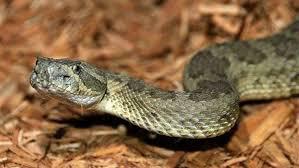
The number of children getting bitten by copperheads and other venomous snakes has more than doubled in recent years, a U.S. study suggests.
Half of the 18,721 snakebites reported to U.S. poison control centers from 2000 to 2013 involved venomous snakes, the study found.
Over that period, reported bites from copperheads surged by 137 percent and bites from other types of venomous snakes increased 107 percent.
These bites are rarely fatal – just four deaths were reported. But one in five cases required admission to intensive care units, and treatments may give some parents sticker shock.
“Treatment of a snakebite can cost easily more than $100,000 if anti-venom is needed,” said lead study author Dr. Joann Shulte, a pediatrics researcher at the University of Louisville in Kentucky.
“I'd suggest that children not go hiking or play in tall grass during the summer without wearing appropriate shoes on their feet,” Shulte, who did the research when she worked at Parkland Memorial Health and Hospital System in Dallas, said by email.
“It is not uncommon at all for children to be bitten wearing flip flops,” Shulte added.
Most snakebites, whether venomous or not, will cause some pain, redness and irritation around the wound site, researchers note in the journal Pediatrics.
Venomous bites can cause symptoms including swelling, death of tissue around the injury, low blood pressure, convulsions, hemorrhage, respiratory paralysis, kidney failure, coma and death.
Rapid emergency care and anti-venom treatment can minimize much of the damage from snakebites, the authors note.
Overall, 38 percent of the snakebites required hospital admissions.
Summers appear to be the worst time of year for snakebites, with one-third of these injuries reported in June and July.
More than two-thirds of the children and teens bitten by snakes were boys.
Just over one third of bite victims were between 3 and 9 years old, and another third were 10 to 14 years old.
While bites happened in all 50 states, they were concentrated in four. Texas, Florida, North Carolina and Georgia accounted for 39 percent of the bites.
One limitation of the study is that it only included snakebites reported to poison control centers, which may not capture every case, the authors note. It’s also possible the type of snakes involved may have been misidentified in some instances.
The study didn’t examine why reports of snakebite have shot up, but Schulte said it’s difficult to know if more children are being bitten because not all bites are reported to poison control centers and it's possible reporting has increased rather than snakebites.
Bites from certain snakes, like copperheads, are probably being reported more because anti-venom is being used and this often requires guidance from toxicologists at poison control centers, Schulte added.
Snakebites in children are rare, and usually random events, noted Dr. Brendan Campbell, medical director of the Pediatric Trauma Program at Connecticut Children’s Medical Center in Hartford.
But the findings highlight the need for parents to take precautions to prevent bites and act quickly when one is suspected, Campbell, who wasn’t involved in the study, said by email.
“Parents should have their children wear shoes while playing outdoors (for reasons that go beyond preventing snakebites), and never allow their children to approach or handle potentially poisonous snakes,” Campbell said.
“The most important thing parents should do if their child is bitten by a snake is (if possible) identify the type of snake, and take their child to the nearest hospital, so local experts on snakebite management can be consulted, and transfer to a pediatric trauma center arranged for if necessary,” Campbell added.
Before anti-venom treatments became widely available, around one in four snakebites were fatal, noted Dr. Fesih Aktar, a researcher at Dicle University in Diyarbakir, Turkey, who wasn’t involved in the study.
With rapid emergency interventions and anti-venom treatment, however, less than 1 percent of snakebites are fatal, Aktar added by email.
Source: Reuters
 FR
FR EN
EN AR
AR








